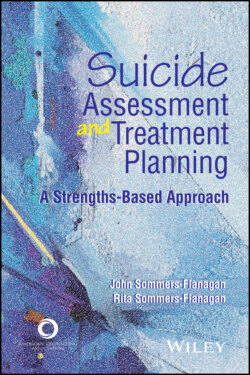Читать книгу Suicide Assessment and Treatment Planning - John Sommers-Flanagan - Страница 12
Practical Realities
ОглавлениеOften, as in the case of Alina, concerns about suicide emerge partway into a session, even though suicidality was not the primary reason for the referral or meeting. Other times suicidality will be the immediate issue demanding your focus. In still other scenarios, your client will not mention distress or suicide until near the end of the session, leaving you with very little time to deal with a very big issue.
As you develop competence for handling suicide scenarios, at a minimum, you have your own attitudes and values to examine; assessment skills to learn, practice, and memorize; professional and ethical responsibilities to manage; intervention strategies to consider; and many other competencies to acquire and fine-tune. No wonder this is a stressful domain for most counselors. If thinking about these responsibilities causes you anxiety, you are not alone. Most health and mental health care professionals rate suicide assessment, management, and treatment planning as one of their greatest stressors (Binkley & Leibert, 2015; Maris, 2019). When clients talk about suicide, it is natural to begin worrying about a range of issues, including potential hospitalization and your responsibilities for keeping clients and students alive.
Increased suicide rates have translated into increased demand for competent professional assessment and treatment services. Unfortunately, suicide assessment and treatment competencies have not been systematically integrated into the training curricula of students in counseling, psychology, social work, nursing, and psychiatry (Cramer et al., 2013; Granello, 2010a; Morris & Minton, 2012). This lack of systematic training in suicide assessment and treatment has relevance for you and your practice. Along with most of the mental health and health care workforce, you may feel uncertain about suicide assessments, unclear about how to develop suicide-specific treatment plans, and uninformed about research-supported interventions for clients and students who are suicidal.
Before reading further, take a moment to check in with yourself. You know that this is a book about suicide assessment and treatment planning, but even that obvious fact deserves reflection. Although we are taking a positive, wellness-oriented approach, content in the following pages and chapters can and will be activating. You will find yourself reacting to the material.
In many places, we write about suicide directly, using actual and constructed suicide cases as well as composite and hypothetical suicide scenarios (note that identifying information is removed or modified to protect confidentiality). Our purpose is to prepare you to work in counseling situations in which suicidality is a concern. We write about suicide in provocative ways for several reasons:
1 You never know whether or when your next client or student will be suicidal. We believe that you can and should be prepared to address suicide and suicidality with competence and confidence.
2 Competence begins with understanding your own attitudes, beliefs, and values. Throughout this book, we will intermittently ask you to check in with yourself and to notice, accept, and manage your thoughts, emotions, and behavioral impulses.
3 Working with clients who are suicidal is emotionally activating. Becoming comfortable with suicide as an issue in counseling is a developmental process that takes time and practice. One way of looking at the content of this book is as an exposure experience that will improve your ability to self-regulate when facing crisis situations as a counseling professional.
If your goals are to become comfortable, confident, and competent when working with clients who are suicidal—and we hope these are your goals—your best route is to strengthen your professional suicide assessment and treatment competencies. Rigorous and direct exposure to suicide-related material in this book and others, along with workshop training and supervision, will get you on track toward professional competence in suicide assessment and treatment.
In the end, we want you to know—in your head and in your heart—that you have the knowledge and skills to provide effective suicide assessment and treatment. Having confidence in your knowledge and skills will be emotionally stabilizing; it will also help you develop a positive and optimistic attitude toward suicide intervention and prevention that you can then pass on to your clients and students.
